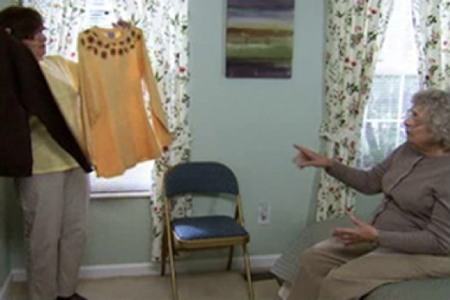Let the Person Make Choices
Help the person stay as independent as possible:
- Allow the person to have choices in what to wear.
- Allow the person with dementia to choose from a limited selection of outfits. If the person has a favorite outfit, consider buying several sets of the same clothes.
- Make it simple for the person to choose clothing to wear. Keep closets free of excess and off-season clothing. Arrange clothing in sets that match.
- Let the person dress him or herself as much as possible. Do not pressure or rush the person.
- Do not criticize or correct the person with dementia, even if the clothing is mismatched.
Make the Person Comfortable
- Give the person as much privacy as possible during dressing.
- It is easier to dress in a room that is not too cold and has good lighting.
- Reduce any embarrassment the person might feel by letting him or her know you will leave the room, but stay close by if they need help.
- Compliment the person on the way he or she looks.
Choose Clothes That are Easy to Put On
- Help the person select clothes that are loose-fitting, especially around the waist and hips. A person recovering from surgery for example, will likely want to wear loose-fitting casual clothes.
- Choose fabrics that are lightweight and smooth in texture.
- Choose clothing that is easy to put on and remove such as:
- Sweaters that button
- Pants with elastic waists
- Shirts and blouses that button in the front
- Pullover shirts with loose necklines
- Half-ankle socks
- Slip-on shoes or shoes with Velcro® fasteners
- Try using Velcro® instead of buttons, snaps and zippers which may be difficult for the person to handle or grasp.
- Men can more easily put on boxer shorts that have Y-fronts.
- Have women wear a sports bra or a tank without fasteners.
- If a person cannot get out of bed, have them wear a gown with a back closure.
- A warm, wool cape may be better than a coat as it is easier to put on.
- Remind the person that labels in the garment are the best reminder as to the right and wrong side of the garment.



